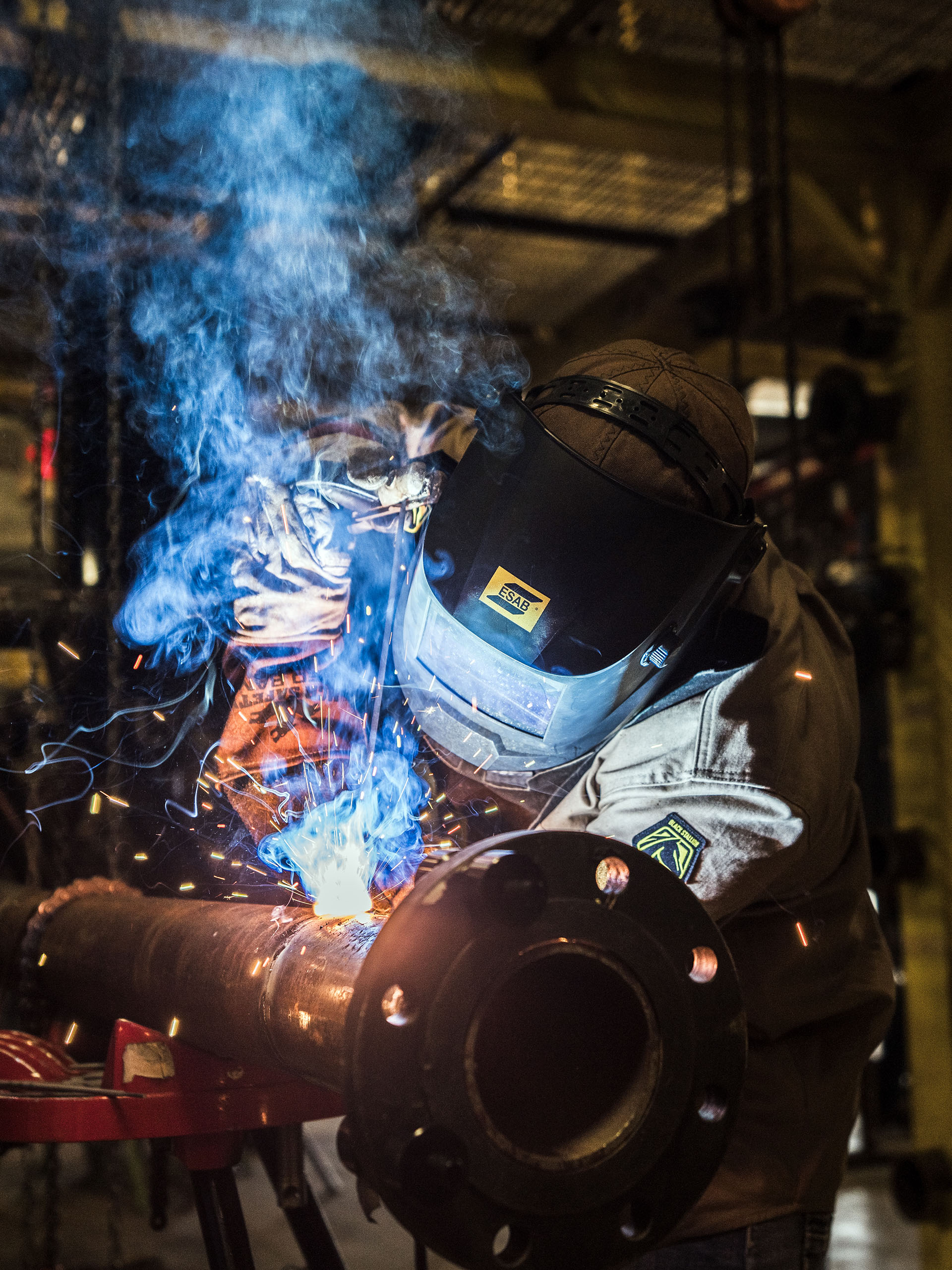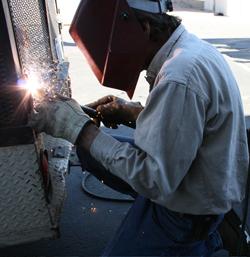Common Welding Repair Work Issues and Exactly How to Address Them Effectively
Welding repairs typically come across a variety of problems that can jeopardize the stability of the end product. Common problems include insufficient penetration, porosity, and misalignment, to name a few. Each flaw offers distinct difficulties that need particular methods for resolution. Understanding these concerns is essential for welders aiming to enhance their outcomes and abilities. This conversation will discover these usual welding repair service problems and effective techniques to address them.
Insufficient Penetration
Insufficient penetration occurs when the weld metal stops working to completely fuse with the base material, causing weak joints and prospective structural failings. This issue usually comes from insufficient warm input, wrong electrode angle, or inappropriate welding speed. Welders might run into poor penetration due to a mistake of the necessary criteria for a details product density or kind. In addition, contamination on the base product's surface can hinder effective bonding, worsening the trouble. To resolve insufficient infiltration, welders need to ensure ideal settings on their equipment and preserve a clean work surface. Normal assessment of welds is suggested to identify any type of shortages early, enabling prompt corrections and the prevention of jeopardized architectural stability in welded settings up.
Porosity
Porosity is a typical flaw in bonded joints that materializes as tiny gas bubbles entraped within the weld steel. This issue can endanger the honesty of the weld, bring about decreased toughness and possible failure under tension. Montana Mobile Welding and Repair Belgrade Welding. Porosity commonly occurs from contamination, dampness, or incorrect welding techniques, which permit gases to leave right into the liquified weld pool. To resolve porosity, welders need to ensure correct surface area preparation, maintain a tidy functioning setting, and utilize suitable welding criteria. Furthermore, selecting the best filler material and protecting gas can alleviate gas entrapment. Routine examination and screening of welds can help determine porosity early, ensuring timely corrective actions are taken, therefore preserving the quality and reliability of the welded structure
Misalignment
Misalignment in welding can develop from numerous elements, consisting of improper arrangement and thermal development. Understanding the source is necessary for reliable resolution. Several adjustment techniques are available to straighten elements and guarantee architectural honesty.
Sources of Imbalance
Welding imbalance frequently originates from a selection of underlying issues that can jeopardize architectural integrity. One main cause is improper fit-up of elements before welding, which can cause voids and unequal surface areas. Variations in thermal development throughout the welding process can additionally result in distortion, specifically if the materials being joined have different coefficients of development. In addition, poor securing and fixturing may stop working to hold components safely in place, leading to movement throughout welding. Poorly maintained equipment, including welding devices and tools, may introduce incongruities in the weld bead, more adding to misalignment. Ultimately, operator error, stemming from inadequate training or experience, can likewise play a substantial duty in developing misaligned welds.
Adjustment Strategies Offered
Addressing imbalance efficiently requires a combination of corrective strategies tailored to the particular issues at hand. One usual technique is the use of jigs or fixtures to hold elements in the appropriate position throughout welding, ensuring consistent positioning. Furthermore, preheating the products can help in reducing distortion and enhance fit-up. For substantial misalignment, mechanical realignment techniques, such as using hydraulic jacks or clamps, can be employed to correct the position prior to welding. Post-weld warm treatment may likewise be required to ease stress and anxieties triggered by imbalance. Cautious assessment and change during the setup phase can avoid misalignment problems from becoming substantial issues, promoting a smoother welding procedure and boosting overall architectural integrity.
Distortion
Distortion is a common challenge in welding that can arise from various factors, including unequal heating & cooling. Recognizing the root causes of distortion is essential for executing reliable avoidance methods. Addressing this problem not only improves architectural honesty yet additionally enhances the total top quality of the weld.
Sources of Distortion
When subjected to the extreme warm of welding, products typically undergo adjustments that can lead to distortion. This sensation primarily develops from thermal growth and tightening throughout the welding process. As the weld area heats up, the product broadens; upon cooling, it contracts, which can create interior stresses. Additionally, unequal home heating throughout a work surface can intensify these stresses, resulting in bending or bending. The kind of product additionally plays a considerable duty; steels with varying thermal conductivity and coefficients of expansion may respond in different ways, leading to unforeseeable distortions. Furthermore, poor joint design and poor fixturing can add to misalignment throughout welding, raising the likelihood of distortion. Understanding these reasons is crucial for reliable welding repair service and avoidance strategies.
Prevention Techniques
Effective prevention methods for distortion during welding concentrate on regulating heat input and guaranteeing correct joint layout. Maintaining a constant warmth input assists to decrease thermal growth and tightening, which can lead to distortion. Using strategies such as pre-heating the workpiece can likewise minimize the temperature level gradient, promoting uniform home heating. In addition, selecting proper joint styles, such as T-joints or lap joints, can improve security and reduce stress focus. Executing appropriate fixturing to secure the workpieces in location further help in maintaining placement throughout the welding process. Ultimately, staggered welding sequences can disperse heat much more evenly, avoiding localized distortion. By using these strategies, welders can significantly lower the chance of distortion and boost the general high quality of their welds.
Splitting
Breaking is an usual problem experienced in welding repair services, often arising from various elements such as incorrect air conditioning rates, product option, or inadequate joint preparation. The event of splits can considerably compromise the integrity of the weld, leading to prospective failings throughout procedure. To address this issue, welders need to initially analyze the origin, making sure that products are suitable and appropriately picked for the details application. In addition, controlling the cooling price throughout the welding procedure is necessary; fast air conditioning can generate anxiety and lead to cracking. Proper joint design and preparation also add to minimizing the risk. Implementing these approaches can enhance weld high quality and longevity, ultimately lowering the learn this here now chance of fracturing in ended up weldments.

Insufficient Fusion
A substantial issue in welding repair services is incomplete combination, which takes place when the weld metal does not adequately bond with the base material or previous weld passes - Montana Mobile Welding and Repair Fabrication. This flaw can bring about best welder for aluminum weaknesses in the joint, potentially jeopardizing the honesty of the welded framework. Factors contributing to insufficient blend include not enough warmth input, inappropriate welding method, and contamination of the surface areas being joined. To address this issue properly, welders need to guarantee proper pre-weld cleaning and surface prep work, as well as adjust their welding criteria to attain ample penetration and blend. Regular inspection throughout the welding process can likewise help recognize incomplete combination early, enabling timely restorative steps to improve the total quality of the weld
Overheating
While welding repair services can improve architectural stability, overheating provides a substantial difficulty that can result in product destruction. Too much warm during welding can change the mechanical buildings of metals, leading to decreased stamina, raised brittleness, and warping. This sensation is particularly critical in high-stress applications where architectural integrity is critical. Recognizing overheating can include aesthetic examinations for staining or distortion, as well as keeping track of temperature throughout the welding process. To minimize the risks connected with mig wire getting too hot, welders ought to employ ideal methods, such as regulating warmth input, readjusting travel rate, and using ideal filler materials. Furthermore, executing pre- and post-weld warm treatments can help recover material residential or commercial properties and improve the overall high quality of the repair work, guaranteeing lasting efficiency and safety and security.
Regularly Asked Concerns
What Are the Typical Indicators of a Welding Issue?

Exactly How Can I Check My Welds for High quality?
To examine welds for quality, one can use aesthetic examinations, ultrasonic testing, and radiographic approaches. Each method assures architectural stability, recognizes defects, and confirms adherence to defined criteria, ultimately improving the integrity of the bonded joints.
What Safety and security Precautions Should I Take While Welding?
When welding, one need to prioritize security by wearing proper individual protective equipment, making sure correct ventilation, securing flammable materials away, maintaining a clean office, and recognizing environments to protect against accidents and injuries.
Can I Repair a Weld Without Remodeling the Entire Joint?
Repairing a weld without renovating the entire joint is feasible, depending on the damages (Montana Mobile Welding and Repair Fabrication). Methods such as grinding, including filler material, or making use of a welding procedure can properly address particular problems while protecting the bordering structure
What Devices Are Essential for Reliable Welding Repairs?
Vital tools for efficient welding repairs include a welding machine, cable brush, grinder, safety gear, clamps, and filler materials. Each device plays a vital role in making certain quality and security throughout the repair service procedure. Porosity typically develops from contamination, moisture, or improper welding techniques, which enable gases to get away right into the molten weld swimming pool. Poorly conserved tools, including welding machines and tools, may introduce disparities in the weld bead, additional contributing to misalignment. When subjected to the intense warm of welding, products frequently undergo modifications that can lead to distortion. Fracturing is an usual issue encountered in welding repair work, often resulting from numerous factors such as improper air conditioning prices, material option, or inadequate joint prep work. A significant problem in welding repair work is incomplete combination, which occurs when the weld metal does not properly bond with the base material or previous weld passes.